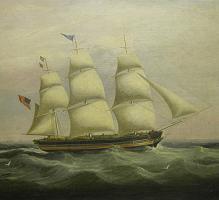
This week, Book Expo America and Book-Con, collectively among of the largest book publishing events in the world, are being held in New York City, on the Hudson River in the Javit’s Center. (My novel, The Shantyman, is one of seemingly countless books on display.)
It seems a good time to ask the question, “Why did New York become the book publishing center of the United States? Why not Philadelphia, or Boston or Chicago? The answer may be piracy, packet ships and the Erie Canal.
Piracy
For roughly the first one hundred years of the existence of the United States, the republic did not acknowledge English copyrights. This allowed the American publishing houses to steal the work of English authors without paying royalties. Many of the publishing names still known in the 20th century started out as book pirates. As described in Wallace and Burrows, Gotham: A History of New York City to 1898:
The big money, however, came from pirated editions of English authors (who didn’t have to be paid royalties because the United States government refused as yet to recognize foreign copyrights). Printers and book dealers in New York and Philadelphia competed furiously to bring out the first American editions of new English novels. Some sent agents to England with orders to grab volumes from bookstalls, or sheets from printshops, and ship them west by fast packet. Copy was then rushed from the dock to the composing room, presses run night and day, and books hurried to the stores or hawked in the streets like hot corn.
No one was better at this than the Harper brothers of New York. Their firm began as a printshop in 1817 and evolved over the next decade into a full-time publishing house that kept popular titles in circulation (birthing the backlist). On one celebrated occasion, borrowing techniques from the newspaper trade, the Harpers retrieved the third volume of Walter Scott’s Peveril of the Peak from a packet before it docked. Working nonstop, they got the finished product to the bookstalls twenty-one hours later, well in advance of the edition issued in Philadelphia by Mathew Carey. It was the Harpers, too, who became the first American commercial publishers to make effective use of stereotyping, a printing process brought to the United States from England in 1811 that was ideal for books frequently reprinted in large editions.
Packet ships
But what gave New York an advantage over Boston or Philadelphia? The answer was another New York innovation — the packet ship. For most of history, ships sailed when they were full of cargo. In 1817, that would change. The New York City based Black Ball Line began offering scheduled service, promising fixed sailing dates. Its first ship, James Monroe, sailed on Christmas Day from New York in a snow storm, half full of cargo and carrying only eight passengers, specifically because that was when they promised that it would sail. The packet ship trade was an immediate success, with other New York and British ship owners quickly joining in. Initially, the packet trade was primarily between New York and London and New York and Liverpool, which guaranteed the New York publishing pirates a steady stream of new books from England before their competition in Philadelphia or Boston could lay their hands on them.
The Erie Canal
So, New York was able to control access to the British books, but how would they distribute them? Inland transportation was terribly expensive. It cost more to transport goods 40 miles inland than it did to bring them across the Atlantic. Roads were terrible. Railroads did not yet exist. In 1817, the same year that the Black Ball Line packets began to sail, work began on the Erie Canal. The first barges started moving on October 26, 1825 bringing grain, timber and produce all the way from the Great Lakes to the Atlantic Ocean at New York City. The empty barges moving back to the center of the country, provided a way for New York publishers to move books, literally by the barge load, cheaply and efficiently. Again from Wallace and Burrows, Gotham: A History of New York City to 1898:
What really assured New York of an unassailable lead in the book trade was cheap and easy access to western readers via the Erie Canal. Every fall, just before the onset of winter, and then again in the spring—a seasonal pattern that still rules the industry—city publishers dispatched crate after crate of books via the canal to retailers scattered across upstate New York, around the Great Lakes, and along the Ohio and Mississippi rivers. Like small-town newspaper editors, local book printers were hard-pressed to compete with the low prices and big-name authors offered by their Manhattan counterparts. The canal helped make it clear, indeed, that selling books wasn’t so very different from peddling hats or chamber pots, and the business soon attracted men who knew nothing about printing but had a talent for marketing. Daniel Appleton, for one, was a Massachusetts storekeeper who moved to New York in 1825 and began to sell books along with groceries. He prospered and by 1831 had decided to become a publisher.
New York publishing has a long and illustrious history, although the roles of packet ships, canal barges, and a size-able dose of piracy seem to have gotten lost in the history.

I enjoyed reading this great story!
Glad that you enjoyed it.
Great post, Rick. Whoda thunk it?
Fascinating story! I especially loved learning about the connection between books and the sea.
Pingback: This Week’s New York History Web Highlights | The New York History Blog
There’s also an Erie canal in Ohio too, most of it now blocked, except during floods.